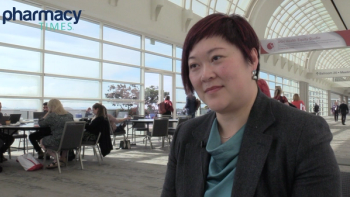
Pharmacists play a vital role in precision oncology, enhancing treatment decisions for metastatic breast cancer through genetic testing and targeted therapies.

Pharmacists play a vital role in precision oncology, enhancing treatment decisions for metastatic breast cancer through genetic testing and targeted therapies.

Explore the impact of GLP-1 medication on weight loss in menopausal women, highlighting the need for personalized treatment approaches.

Megan Dulohery Scrodin, MD, highlights Mayo Clinic's innovative COPD care model, emphasizing multidisciplinary collaboration and AI tools for improved patient outcomes.

Megan Dulohery Scrodin, MD, discusses COPD management challenges and the need for accessible care and cost reduction.

Oncologist Thor Halfdanarson reviews dose-finding data for the targeted α radioligand therapy [^212Pb]VMT- α-NET, highlighting manageable toxicity, stable renal function, and plans for phase 2 evaluation.

Pharmacists enhance patient care by managing CDK4/6 inhibitors, addressing adverse effects and ensuring effective therapy selection in oncology.

Expert shares the evolving role of pharmacy in patient care, emphasizing treatment accessibility and monitoring.

Outpatient use of bispecifics and CAR T-cell therapies in multiple myeloma can expand access.

Scott A. Soefje, PharmD, MBA, BCOP, FCCP, FHOPA, discusses how Medicaid payment changes could impact rural hospitals and local pharmacies, noting the importance of pharmacists staying involved as the situation develops.


Scott Soefje, PharmD, MBA, BCOP, shares insights about the evolving role of pharmacists at the 2025 OPC meeting.

Heidi Finnes, PharmD, BCOP, FHOPA, discusses the evolving landscape of treatment of cutaneous malignancies.

Scott A. Soefje, PharmD, MBA, BCOP, explained how the expanding use of the FDA’s 505(b)(2) drug approval pathway is creating operational and reimbursement challenges for oncology infusion centers.

Nilufer Ertekin-Taner contrasts current one-size-fits-all Alzheimer disease treatments with the promise of precision medicine and emphasizes the vital role of collaborative, multidisciplinary care.

Scott Soefje, PharmD, MBA, BCOP, FCCP, FHOPA, offers insights for oncology pharmacists treating patients with metastatic esophageal squamous cell carcinoma.

Scott Soefje, PharmD, MBA, BCOP, FCCP, FHOPA, discusses a case study of a patient with metastatic esophageal squamous cell carcinoma.

Nilufer Ertekin-Taner outlines how embracing the biological complexity of neurodegenerative diseases can guide the development of precision therapies akin to those used in oncology.

Nadofaragene firadenovec led to most patients with Bacillus Calmette-Guérin-unresponsive non-muscle invasive bladder cancer (NMIBC) experiencing a complete response (CR) at 3 months.

The rising use of prescription stimulants in the US presents significant safety risks, legal challenges, and supply chain shortages, emphasizing the need for pharmacist involvement in promoting responsible prescribing.

Yi Lin, MD, PhD, highlights the importance of achieving MRD negativity in multiple myeloma, CAR T-cell therapy outcomes, and the critical role of pharmacists in patient care.

Eculizumab (Soliris; Alexion), a C5 inhibitor preventing cleavage into C5a and C5b, is widely considered the first-line therapy for high-risk TA-TMA.

As of now, data suggest minimal risk of drug interactions between oral contraceptives and injectable semaglutide.

The AHA acknowledged that complementary and alternative medicines are widely used by heart failure patients but warned that there is limited scientific evidence to support their efficacy.

Currently, the CDC recommends the recombinant zoster vaccine (Shingrix, RZV; GSK) for the prevention of herpes zoster and related complications.

Using biosimilars and generics as well as getting patients connected with manufacturer copay assistance or grant programs can reduce their out-of-pocket costs.

Clayton Irvine, PharmD, MBA, MS, notes that although these options help to lower the cost of care, quick, widespread implementation remains difficult.

Automation and artificial intelligence can also aid significantly in reducing time-consuming tasks and improving efficiency for pharmacists, allowing them more time with patients.

However, the cost of zuranolone makes it challenging to access and justify, given study results comparing it with brexanolone.

More cost effectiveness data is crucial in advocating for better insurance coverage in the United States.

Anatomical alterations result in many downstream changes, such as changes in pH, gastric volume, food intake, surface area for absorption, gastric emptying and transit times, and intestinal enzymes and efflux pumps, among others.